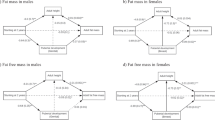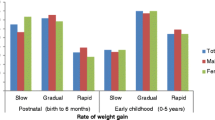Abstract
Background:
Cross-sectional studies have shown associations between stunting and overweight; however, there are few prospective studies of stunted children.
Objectives:
To determine whether stunting before age 2 years is associated with overweight and central adiposity at 17–18 years and whether growth in height among stunted children predicts body mass index (BMI) in late adolescence.
Design:
Prospective cohort study.
Participants:
One-hundred and three participants stunted by age 2 years and 64 non-stunted participants (78% of participants enrolled in childhood). Participants were measured in early childhood and at ages 7, 11 and 17 years.
Results:
Stunted subjects remained shorter and had lower BMIs, smaller skinfolds and circumferences than non-stunted subjects. Overweight (BMI ⩾25 m2) was not significantly different among stunted and non-stunted male subjects (5.2 and 12.5%) but non-stunted female subjects were more likely to be overweight than those who experienced early childhood stunting (11.1 and 34.4%, P=0.013). Centralization of fat (waist to hip ratio (WHR), subscapular/triceps skinfold ratio (SSF/TSF)) did not differ between stunted and non-stunted groups (mean WHR 0.77 and mean SSF/TSF 1.18 in both groups). Stunted subjects with greater increases in height-for-age for the intervals 3–7 and 7–11 years had higher BMI at age 17 years (P=0.04 and P=0.001, respectively).
Conclusion:
Participants stunted by age 2 years were less likely to be overweight than those who were never stunted. This suggests that cross-sectional studies of the association between stunting and overweight may be misleading. Among stunted children, greater linear growth during mid- to late childhood was associated with greater BMI at age 17 years.

Similar content being viewed by others
References
United Nations System SCN. Fifth report on the world nutrition situation. SCN: Geneva, Switzerland, 2004.
Monteiro CA, Conde WL, Popkin BM . Is obesity replacing or adding to undernutrition? Evidence from different social classes in Brazil. Public Health Nutr 2002; 5: 105–112.
Popkin BM . The nutrition transition and obesity in the developing world. J Nutr 2001; 131: 871S–873S.
Sawaya AL, Dallal G, Solymos G, de Sousa MH, Ventura ML, Roberts SB et al. Obesity and malnutrition in a Shantytown population in the city of Sao Paulo, Brazil. Obes Res 1995; 3 (Suppl 2): 107s–115s.
Jackson M, Samms-Vaughan M, Ashley D . Nutritional status of 11–12-year-old Jamaican children: coexistence of under- and overnutrition in early adolescence. Public Health Nutr 2002; 5: 281–288.
Popkin BM, Richards MK, Montiero CA . Stunting is associated with overweight in children of four nations that are undergoing the nutrition transition. J Nutr 1996; 126: 3009–3016.
Mukuddem-Petersen J, Kruger HS . Association between stunting and overweight among 10–15-y-old children in the North West Province of South Africa: the THUSA BANA Study. Int J Obes Relat Metab Disord 2004; 28: 842–851.
Hoffman DJ, Sawaya AL, Verreschi I, Tucker KL, Roberts SB . Why are nutritionally stunted children at increased risk of obesity? Studies of metabolic rate and fat oxidation in shantytown children from Sao Paulo, Brazil. Am J Clin Nutr 2000; 72: 702–707.
Sawaya AL, Grillo LP, Verreschi I, Da Silva AC, Roberts SB . Mild stunting is associated with higher susceptibility to the effects of high fat diets: studies in a shantytown population in Sao Paulo, Brazil. J Nutr 1998; 128: 415S–420S.
Walker SP, Gaskin PS, Powell CA, Bennett FI . The effects of birth weight and postnatal linear growth retardation on body mass index, fatness and fat distribution in mid and late childhood. Public Health Nutr 2002; 5: 391–396.
Benefice E, Garnier D, Simondon KB, Malina RM . Relationship between stunting in infancy and growth and fat distribution during adolescence in Senegalese girls. Eur J Clin Nutr 2001; 55: 50–58.
Schroeder DG, Martorell R, Flores R . Infant and child growth and fatness and fat distribution in Guatemalan adults. Am J Epidemiol 1999; 149: 177–185.
Li H, Stein AD, Barnhart HX, Ramakrishnan U, Martorell R . Associations between prenatal and postnatal growth and adult body size and composition. Am J Clin Nutr 2003; 77: 1498–1505.
Ong KK, Ahmed ML, Emmett PM, Preece MA, Dunger DB . Association between postnatal catch-up growth and obesity in childhood: prospective cohort study. BMJ 2000; 320: 967–971.
Hamil P, Drizd T, Johnson C, Reed R, Roche A . Growth curves for children, birth–18 years 165 (DHEW # 78-1650) National Center for Health Statistics: Hyatsville, MD, 1977.
Grantham-McGregor SM, Powell CA, Walker SP, Himes JH . Nutritional supplementation, psychosocial stimulation, and mental development of stunted children: the Jamaican Study. Lancet 1991; 338: 1–5.
Walker SP, Powell CA, Grantham-McGregor SM, Himes JH, Chang SM . Nutritional supplementation, psychosocial stimulation, and growth of stunted children: the Jamaican study. Am J Clin Nutr 1991; 54: 642–648.
Powell C, Grantham-McGregor S . Home visiting of varying frequency and child development. Pediatrics 1989; 84: 157–164.
Grantham-McGregor SM, Walker SP, Chang SM, Powell CA . Effects of early childhood supplementation with and without stimulation on later development in stunted Jamaican children. Am J Clin Nutr 1997; 66: 247–253.
Walker SP, Grantham-McGregor SM, Himes JH, Powell CA, Chang SM . Early childhood supplementation does not benefit the long-term growth of stunted children in Jamaica. J Nutr 1996; 126: 3017–3024.
Lohman TG, Roche A, Martorell R . Anthropometric Reference Manual. Human Kinetics Books: Champaign, IL, 1988.
Kuczmarski RJ, Ogden CL, Grummer-Strawn LM, Flegal KM, Guo SS, Wei R et al. CDC growth charts: United States. Advance data from vital and health statistics no. 314. National Center for Health Statistics: Hyattsville, MA, 2000.
Mendez MA, Cooper RS, Luke A, Wilks R, Bennett F, Forrester T . Higher income is more strongly associated with obesity than with obesity-related metabolic disorders in Jamaican adults. Int J Obes Relat Metab Disord 2004; 28: 543–550.
Freedman DS, Khan LK, Mei Z, Dietz WH, Srinivasan SR, Berenson GS . Relation of childhood height to obesity among adults: the Bogalusa Heart Study. Pediatrics 2002; 109: E23.
Acknowledgements
We thank Amika Wright for conducting the measurements. The study was supported by a grant from the Wellcome Trust (066088).
Author information
Authors and Affiliations
Corresponding author
Rights and permissions
About this article
Cite this article
Walker, S., Chang, S. & Powell, C. The association between early childhood stunting and weight status in late adolescence. Int J Obes 31, 347–352 (2007). https://doi.org/10.1038/sj.ijo.0803383
Received:
Revised:
Accepted:
Published:
Issue Date:
DOI: https://doi.org/10.1038/sj.ijo.0803383
- Springer Nature Limited
Keywords
This article is cited by
-
Association between anthropometric criteria and body composition among children aged 6–59 months with severe acute malnutrition: a cross-sectional assessment from India
BMC Nutrition (2022)
-
Body composition of children with moderate and severe undernutrition and after treatment: a narrative review
BMC Medicine (2019)
-
Effect of correcting for gestational age at birth on population prevalence of early childhood undernutrition
Emerging Themes in Epidemiology (2018)
-
Early growth faltering in post-institutionalized youth and later anthropometric and pubertal development
Pediatric Research (2017)
-
Are stunted young Indonesian children more likely to be overweight, thin, or have high blood pressure in adolescence?
International Journal of Public Health (2017)




